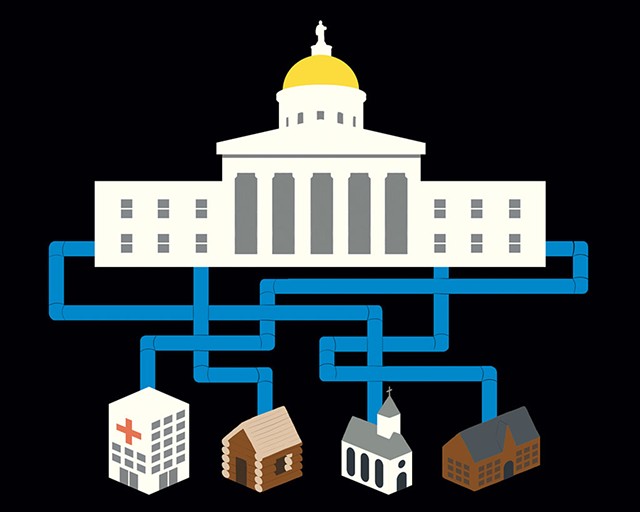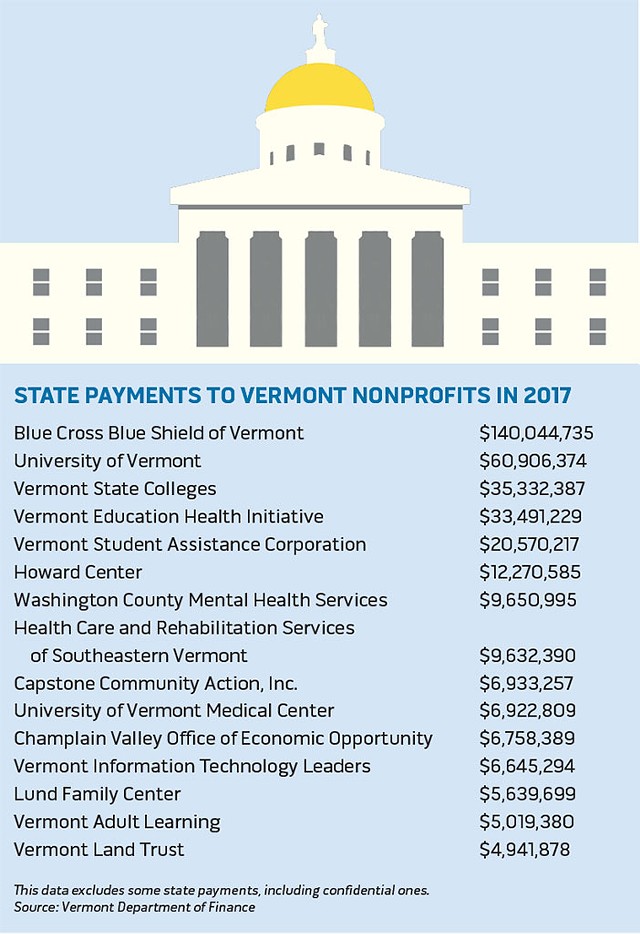
- Thomas James
Over the last 50 years government in the Green Mountains has withdrawn from providing many direct services to Vermonters in need. Instead, the state has outsourced that job — and hundreds of millions of dollars — to an ad hoc network of dozens of private nonprofit groups. They feed the hungry, house the homeless, care for the mentally ill and assist the developmentally disabled.
These organizations tend to be more nimble, innovative and attuned to the needs of their community. Often they can deliver services at a bargain compared to state government.
The arrangement seems appropriate in a state that cherishes local decision making but lacks county government, which might otherwise do the work. It fulfills the conservative desire for limited government and liberal support of humane, community-based programs.
But this public-private safety net has vulnerabilities. It has grown so large and sprawling that no one in state government is able to say exactly how much taxpayer money goes to the nonprofit agencies.
"It's millions and millions of dollars," said Sen. Jane Kitchel (D-Caledonia), chair of the Senate Appropriations Committee and a former secretary of the Agency of Human Services. "Is there a master list? Uh, no, I don't think so."
"Nobody knows who's doing what," added Human Services Secretary Al Gobeille, describing the hodgepodge of social service organizations, some of which have similar or overlapping missions.
And while the network of organizations has grown, funding for essential services has shrunk, straining the system and making some policy leaders question whether government is shirking its duties to residents by underpaying the nonprofits that provide critical state services.
The theory was "You could do it cheaper in the community than you could in state government," said Scott Johnson, who worked in state government and led one of Vermont's 15 nonprofit parent-child centers, the Lamoille Family Center. "That worked fine for 25, 30 years — as long as there was money."
A total of 498 Vermont nonprofits reported income from government grants on their most recent federal tax forms, according to Seven Days' database of Internal Revenue Service filings. Many were founded, or grew into expanded roles, in the 1960s and 1970s as a result of two big changes in how social services are delivered in the United States.
President Lyndon Johnson's War on Poverty in the '60s spawned more than 1,000 "community action agencies," publicly funded private nonprofits charged with rooting out poverty within their communities.
Vermont has several such agencies today, whose missions encompass a broad range of activities: housing assistance, preschool, domestic violence support, weatherization and heating fuel subsidies, to name a few.
They rely almost exclusively on government funding and receive a lot of it. In fiscal year 2017, the state paid $6.9 million to Capstone Community Action, which serves central Vermont. Northwest Vermont's Champlain Valley Office of Economic Opportunity got $6.7 million.
Another wave of nonprofits grew up as Americans rejected the practice of warehousing people with mental illness and disablities in state-run institutions. In 1993, Vermont closed the Brandon Training School, the state's facility for those with developmental disabilities, and began moving individuals out of the Vermont State Hospital, which once housed more than 1,000 patients. Its census had declined to about 50 people by the time Tropical Storm Irene flooded and permanently closed the Waterbury facility in 2011.
State officials came to agree that it was more humane to treat such individuals in venues closer to their families. To deliver that care, Vermont turned to social service nonprofits such as Washington County Mental Health and Northeast Kingdom Human Services, giving them regional monopolies and assigning them legal responsibility for the mentally ill and developmentally disabled in their communities.
Today, these 11 regional "designated agencies" plus five "specialized service agencies," which provide more individualized services, care for 35,000 clients a year, at a cost of about $414 million. The state and federal government pay more than 90 percent of the bill.
The state also began contracting with several private nonprofit hospitals, such as the Brattleboro Retreat, to provide beds to patients who require intensive mental health care. Vermont's annual tab for inpatient psychiatric care in 2017 was roughly $38 million.
Labor of Love

Hundreds of Vermont social service agencies receive checks from Montpelier, but other nonprofits get government funding, too.
The state relies on nine housing authorities as well 16 land trusts and housing development corporations to provide affordable housing and conserve land.
Twelve regional development corporations are charged with spurring economic development.
Vermont even relies on a nonprofit to maintain its network of snowmobile trails. In 1997, the state turned the job of running several highway rest areas over to nonprofit chambers of commerce. More recently it created Vermont Parks Forever, a private nonprofit to promote state parks.
There's good reason to rely more on nonprofits, according to Steve Dale, a former Department for Children and Families commissioner who previously worked at the Howard Center, the Burlington-based provider of mental health, disability and addiction treatment that is the state's largest designated agency.
Dale said nonprofits are less constrained by politics and more concerned with their communities' needs, in part because the board members who oversee them are locals.
He offered an example: When he was at the Howard Center in the early 2000s, governor Howard Dean and other state leaders resisted opening a methadone clinic to treat opioid addiction. But, as Dale recalled it, the Howard Center board, which had an up-close view of Chittenden County's escalating addiction problem, overcame state-level opposition to open a clinic in Burlington in 2002.
"It was the perfect example of local people taking responsibility that would not likely have been taken if it was a state agency," Dale said.
"I think one of the real strengths of our system is local involvement," agreed Doug Racine, a former lawmaker who was human services secretary under governor Peter Shumlin.
Another advantage: "The taxpayer is getting a great bang for the buck by having nonprofits doing this," said Mark Redmond, executive director of Spectrum Youth & Family Services, a Burlington-based nonprofit that serves at-risk youth.
Nonprofit directors in Vermont have described their organizations as both a cheap date for state government and its bastard child.
While government largesse has always ebbed and flowed, money has been particularly tight since the Great Recession. Without bargaining power and labor union protections for their employees, nonprofits make an easy target for budget cuts.
"The government can shortchange them," Racine said.
Many nonprofit directors report that state funding has been reduced or has failed to keep pace with inflation and rising caseloads. They turn to private donors to make up the difference, which can be a costly endeavor. Johnson estimated that the Lamoille Family Center had doubled its fundraising in the past eight years but noted that there is "a tremendous amount of competition at the local level."
Bleeding these organizations to death, as Johnson put it, is "unconscionable."
Nonprofit workers are generally paid lower salaries and receive fewer benefits than state employees, who are represented by a powerful union that negotiates annual raises on their behalf. Last year, the legislature gave the designated agencies an additional $8 million to ensure that their workers were making at least $14 an hour. But according to the designated agencies' analysis, it would take another $70 million to bring their employees' pay up to what equivalent state workers make. Similarly, parent-child centers have determined it would take $8 million to close their wage gap.
As a result, nonprofits regularly lose staff — sometimes to state government. Johnson said several Lamoille Family Center employees left for state jobs and immediately began making approximately $10,000 more.
Turnover forces organizations to expend limited dollars to hire and train new staff members. The Howard Center is among those that have struggled to find and keep employees.
Legislation prompted the Green Mountain Care Board to review the designated agency's finances in 2016. It concluded, "We believe that underfunding of the organization, resulting in significant staffing gaps and challenges, in turn leads to substantial unmet needs in the community Howard Center serves and hardship for those individuals and families." At the time, the center had 104 open positions.
Racine's take: "We as a society and government are taking advantage of folks who are willing to work for lower pay because they are really committed to others."
Money's Worth
The Vermont State Employees' Association isn't pleased with the arrangement, either, viewing privatization as a threat to its members. The union points to the example of the Vermont Association of Business Industry and Rehabilitation, whose roughly 80 employees help find jobs for Vermonters with developmental disabilities.
The nonprofit works almost exclusively with the State of Vermont, and its employees sit alongside state workers, rent free.
Diane Dalmasse, who directs the Department of Disabilities, Aging and Independent Living's vocational rehabilitation program, described VABIR, which has partnered with the state since 1979, as "our employer arm." Dalmasse said the model is highly effective and vigorously disputed the union's claim that the nonprofit's employees had replaced laid-off state workers.
At the same time, she was unable to explain why a nonprofit was better equipped to provide those services than state government. "If the administration and the legislature wanted to give us 80 positions, that would be fine," she said.
While there's a general sense that nonprofits do more than the state government pays them for, no one seems to know how much the government spends on them collectively.
"We're trying to get it under control," said Gobeille, who explained that his agency has worked for months to catalog the various grants awarded to organizations. Gobeille said most recipients are nonprofits, but the review didn't distinguish between nonprofit and for-profit entities.
In fiscal year 2017, the Agency of Human Services paid $414 million to the designated and special services agencies; gave 686 grants totaling $121 million in federal money and $77 million in state money to other private organizations; and awarded millions more — it hasn't calculated how much — in contracts for specific services not covered by grants.
And, of course, that's just one agency.
"I think we're working on it," Kitchel said of the oversight challenge, but there are still times when "we are not disciplined enough to go back and say, 'Did we get what we should have?'"
In 2014, State Auditor Doug Hoffer found that the Department of Mental Health and the Department of Disabilities, Aging and Independent Living weren't always following up to make sure designated agencies provided the services paid for by the state.
In response to that audit, and at the urging of federal officials, Gobeille is trying to move away from the state's practice of paying nonprofits before services are rendered. The change wouldn't apply to certain block grants, but it could affect a wide array of organizations.
The prospect of getting compensated after the fact is extremely unsettling for small organizations that lack the cash to cover their costs in the meantime.
Mary Paul "Pixie" Loomis is the outgoing director of Vermont Adult Learning, one of four nonprofits the state pays to teach English language learners, high school dropouts and others. She warned that the change could be a "kiss of death" for her nonprofit, which was already "shriveling on the vine in an environment of level funding."
Gobeille said the state might make exceptions in transitioning to the new payment method. "I don't want this to be painful," he said.
Tightening protocols is one thing; ensuring the work is done well is an entirely different challenge.
That was one of Racine's unrealized goals when Shumlin fired him.
"What I was pushing for was greater accountability," he said. "I wanted to produce more data on how different organizations in different parts of the state were doing ... I knew anecdotally that some were stronger and some were weaker, but I didn't have the tools to measure it."
Hoffer said that in most cases, his office is only authorized to determine whether nonprofits are meeting the requirements of their agreements with the state — meaning his oversight ability is only as strong as those requirements.
Departments typically have employees dedicated to the task of overseeing grants and contracts, but during his audit of designated agencies, Hoffer noted that some of these state positions had been cut.
In recent years, the state has worked to create more metrics that gauge the quality, not just the quantity, of the services it commissions — but it's a work in progress. An open question, according to Kitchel, is, "Are we measuring the right outcomes?"
'It's Just Tons of Money'
The inconsistent and byzantine nature of the system frustrates nonprofits, many of which juggle dozens of grants from multiple departments, each with different requirements, some more rigorous than others.
"Oh, it's terrible for them," said Gobeille. "We are wasting a ton of money and time."
Rep. Barbara Rachelson (D-Burlington) is the executive director of the Lund Center, a nonprofit that provides adoption services, substance abuse treatment, education and family support programs. Rachelson recalled working with the Shumlin administration in 2014 to try to simplify the number of governments grants her organization received. She was shocked when the state brought together all its employees who oversaw Lund's funding — they filled a large conference room. The effort never went anywhere.
Having inventoried the 686 grants, Gobeille said he now wants to figure out whether the agency can dole out money more effectively.
Could that mean cutting down on duplicative programs?
Possibly, Gobeille said. But until there's evidence of that problem, "I don't want everybody worrying."
In fact, it could lead to more replication by making it easier for the state and its grantees to share strategies. In some cases, the state paid for a program, and then "We never studied it; we never saw if it was a best practice, and then we never replicated it," said Gobeille.
"It's just tons of money," Gobeille said, "and it's something that should be managed."
Cautionary examples can be found elsewhere in state government.
In 2005, governor Jim Douglas signed legislation that created the Vermont Information Technology Leaders, a nonprofit tasked with building a statewide database of health records. Douglas officials hoped it would bring in private money, putting less strain on the state budget, but that didn't pan out. Instead, the state went on to allocate more than $40 million to the organization, and even so, VITL struggled at one point to make payroll.
After a 2016 audit concluded that the state was failing to oversee VITL, lawmakers commissioned an independent report. It found that, more than a decade after it was created, the nonprofit had only managed to put 19 percent of medical records into its database.
The VITL case highlights another obstacle to accountability: Arguing that it wasn't a public entity, the organization fought public records requests from citizen-advocate Stephen Whitaker of Montpelier in Washington Superior Court. Judge Mary Miles Teachout ruled that the nonprofit had to comply with the records law.*
For better or worse, the divide between the public and private sectors has become decidedly blurry.
Gretchen Morse, a former state rep who became then-governor Madeleine Kunin's human services secretary in 1985 and later led the nonprofit United Way of Chittenden County, recalled that when the state began handing more responsibility to designated agencies and other nonprofits, "we used to really ponder: What's the role of the community and what's the role of the state?"
Both she and Kitchel suggested it might be time for the state to revisit that question.
"At some point, we need to define what are the core services [of government] and fund them adequately," Kitchel said. That, she cautioned, could lead to "hard choices about what we don't provide."













Comments (4)
Showing 1-4 of 4
Comments are closed.
From 2014-2020, Seven Days allowed readers to comment on all stories posted on our website. While we've appreciated the suggestions and insights, right now Seven Days is prioritizing our core mission — producing high-quality, responsible local journalism — over moderating online debates between readers.
To criticize, correct or praise our reporting, please send us a letter to the editor or send us a tip. We’ll check it out and report the results.
Online comments may return when we have better tech tools for managing them. Thanks for reading.